A History of the County of Bedford: Volume 2. Originally published by Victoria County History, London, 1908.
This free content was digitised by double rekeying. All rights reserved.
'Parishes: Flitton cum Silsoe', in A History of the County of Bedford: Volume 2, ed. William Page (London, 1908), British History Online https://www.british-history.ac.uk/vch/beds/vol2/pp325-333 [accessed 9 May 2025].
'Parishes: Flitton cum Silsoe', in A History of the County of Bedford: Volume 2. Edited by William Page (London, 1908), British History Online, accessed May 9, 2025, https://www.british-history.ac.uk/vch/beds/vol2/pp325-333.
"Parishes: Flitton cum Silsoe". A History of the County of Bedford: Volume 2. Ed. William Page (London, 1908), British History Online. Web. 9 May 2025. https://www.british-history.ac.uk/vch/beds/vol2/pp325-333.
In this section
FLITTON CUM SILSOE
Flichtam (xi cent.); Flitte, Flute (xii–xiv cents.); Sewilessou, Siwilessou (xi cent.); Sivelesho, Syvylyshoo (xii–xvi cents.).
Silsoe, which is now a separate parish, was included as a hamlet in the parish of Flitton before 1831. Its area at the present day is 2, 157½ acres, of which 12 are covered by water, 691 are arable land, 1, 266¾ permanent grass, and 140½ woods and plantations. (fn. 1) The soil is of clay and sand, with a subsoil of strong clay and loamy sand. There are many old clay, gravel, and sand-pits in the parish, most of which are now destroyed. The ground is irregular, the highest elevation, 259 ft., being found in the north-west of the parish near Newbury Farm Moat. The lowest point, 173 ft., lies in the park which surrounds Wrest House, the property of Lord Lucas and Dingwall, and now occupied by the Hon. Whitelaw Reid, the American ambassador. The park, which is studded with fine trees, occupies about 500 acres of ground, over which large herds of deer roam. The house was built between 1834 and 1839 by the first Earl de Grey and Baron Lucas, after his own designs, the former house being then destroyed: it stood at some distance to the north, on lower ground. The present house is of two stories and an attic, with projecting bays at the centre and angles of the south front, which looks on to the terrace and gardens, having the offices and stables, &c., to the east. A large sheet of artificial water lies to the south, having at its south end a classic pavilion designed by Thomas Archer in 1709, and the grounds, which were laid out by Lancelot Brown in the eighteenth century, abound with fine trees, the principal avenue leading to the house being of elms flanked by Spanish chestnuts. The wilderness, the bowling green, and other parts of the old gardens are preserved, and the great yew hedge surrounding the bath grounds is a notable specimen of its kind. The house contains a good series of portraits by Vandyck, Kneller, Reynolds, and Gainsborough. Together the house and park occupy about a quarter of the area of the parish. The village lies on the Bedford and Luton main road, which skirts the park on the west. Some of the houses are old and quaintly gabled, a group being known as West End, near which lies an old quarry; a footpath leads from here to Windmill Hill, at a short distance away, and is continued until it reaches Thrift Wood.
The parish of Flitton has a smaller area of about 1,061 acres, of which 413¼ are arable land, and 460¾ permanent grass. (fn. 2) The soil is sandy with a subsoil of sandstone, and the crops are wheat, barley, potatoes, and beans. There are several sand-pits situated in the parish, which consists mostly of low-lying meadow land, with some scattered timber: to the west and north lie Flitton and Flitwick Moors. The highest ground in the south of the parish reaches an altitude of 296 ft., while in the north, where Flitton Moor stretches, it falls to 205 ft. The village, situated in the north-east, derives its name from the stream which flows close by it, and is distant about one and a half miles from the Bedford and Luton main road. The church stands on a slight mound on the west side of the village, the vicarage being on the opposite side of the road. Parts of the house are, perhaps, mediaeval, with a small central hall and two wings, but the whole has been much altered and added to, and beyond some seventeenth-century panelling in the hall, there is very little old detail. Some pieces of mediaeval glass, probably from the church, are glazed into the windows of the porch. The parish, which is broad in the north, narrows suddenly in the middle before widening out again in the south; in this narrow isthmus, connecting the two portions, is situated the hamlet of Greenfield, which, however, is partly included in Pulloxhill parish, a small detached part of the latter being inclosed in Flitton.
Among the place-names in Flitton and Silsoe occurs that of a close called Inneland in Worthing in Flitton, which Thomas Worthing inclosed in 1428; (fn. 3) and among the lands granted in 1551 to Edward Warner with the chantry of Silsoe were Kynelfurlong, Waterslade, Coshill, and Hiltonmede, together with a close called the Chanterie. (fn. 4)
A gold coin of Cunobelin was turned up by a labourer in Silsoe in 1855, and was afterwards in the possession of Mr. Wyatt. (fn. 5)
In Flitton there is a piece of ground in the tenure of Mr. Elmore, which is called the Quakers' Burying Ground Corner; in digging, several human skeletons have been found, and a coffin handle; but it must have been disused for more than 150 years. The Pound still exists, and is inclosed by a stone wall covered with moss, but the Lock-up, a round tower with a stone roof, is no longer used for its original purpose. At Flitton Richard Milward, the editor of Selden's Table Talk, was born in 1609, and was possessed of lands in Flitton and Higham Gobion at his death, which took place in 1680. (fn. 6)
An Inclosure Act for Flitton and Silsoe with Pulloxhill was passed in 1809. (fn. 7)
Manors
The manor of WREST in Silsoe, which has been in the possession of the De Greys, earls of Kent, and their descendants for over six hundred years, was held at the time of the Great Survey by Hugh, of Walter, brother of Saher, and was then assessed at 4 hides; it had been held in the time of King Edward by Leofnoth, a thegn. Half a hide, which three sokemen formerly held, was in the possession of Hugh, who claimed to hold it of the king at the date of the Survey. (fn. 8)
It is very probable that Walter, brother of Saher, was related to Walter le Fleming, the ancestor of the barons of Wahull. He was possibly the brother of Walter le Fleming's father, for a Saher is alluded to under Southill, as the predecessor of Walter le Fleming in the reign of William the Conqueror, and both these barons had the same English predecessor, the thegn Leofnoth. (fn. 9) This relationship would account for the fact that by 1284 the manor of Wrest was held of the barony of Wahull. (fn. 10) It continued to be so held until 1623, (fn. 11) after which there is no further record of the overlordship.
Mr. Round considers that the Greys were connected with Bedfordshire, and probably with Flitton, a good deal earlier than 1284–6, when Reginald de Grey is found holding one fee in Flitton and Silsoe of John de Wahull. (fn. 12) He points out that c. 1240 John de Grey was already holding fees of the Wahull barony in Podington, Lee (in Podington), Sharnbrook, Turvey and Henlow, (fn. 13) and that an important plea of 1234 shows Andrew de la Legha as mesne tenant at Lee between Hugh Fitz Richard and John de Grey with Agnes his wife, from whom Andrew held. (fn. 14) In his opinion this plea gives a clue to the means by which the Greys obtained their Bedfordshire estates, that is, by a marriage with an heiress which gave them a local position sufficient for John to be sheriff of the county in the reign of Henry III. Tracing back their fees to 1086, we find that in Domesday, a certain Hugh held of the Wahull fief at Podington, Lee (in Podington), Turvey and Henlow. Mr. Round therefore suggests that these lands descended as a whole, and that their Domesday tenant was one and the same man. But we also find a Hugh holding of the Wahull fief of Canons Ashby (Northamptonshire) in 1086, and as a plea of 1227 proves that the church of Lee, with some land in Podington, was given to Canons Ashby Priory by Hugh de 'Legha' two generations earlier, (fn. 15) we must infer that the Bedfordshire and Northamptonshire 'Hugh' of 1086 were identical also. Mr. Round considers that the Hugh de 'Lega' who held no less than ten fees of the Wahull barony in 1166 (fn. 16) was his representative, and that this conclusion gives us the descent of an important group of manors through Hugh and Bartholomew his son. (fn. 17) He further suggests that the above Hugh was identical with the Hugh who held the Silsoe manor of Walter, Saher's brother, in 1086, and that this would account for that manor also descending through an heiress or co-heiress to the Greys. The Reginald de Grey who was holding in 1284 was summoned to Parliament in 1295 as Lord Grey [de Wilton], and died in 1307–8 seised of the manor, which was then worth £4. (fn. 18)
His son John, who succeeded him, took an active part in the disturbances which marked the reign of Edward II, at first on the side of Lancaster. He was appointed in 1310 one of the Lords Ordainers, but in 1322 he espoused the royal cause and sat in the Parliament at York. (fn. 19) Henry his son by his first wife inherited the title of Lord Grey de Wilton, but the estate in Bedfordshire passed to Roger his son by his second wife. A settlement of Wrest Manor was made on the latter in 1311, (fn. 20) and at his father's death in 1323, the remaining property in Bedfordshire descended to him. (fn. 21) In 1324 Roger was summoned to Parliament as Lord Grey de Ruthyn, in 1327 he accompanied Edmund, earl of Kent, on the Scottish campaign, and between 1340 and 1345 served in Scotland and France. He died in 1352–3, when his son Reginald inherited the manor; (fn. 22) and at the latter's death in 1388 it was worth £13 a year. (fn. 23) Reginald's son Reginald was summoned to Parliament in 1389, and in 1398 he acted for a short time as governor in Ireland, after the death of Roger, earl of March. He was engaged in suppressing the disturbances in the Welsh Marches during 1400 and 1401, but early in 1402 was taken prisoner, remaining a captive throughout the whole year. (fn. 24) He died in 1440–1 and was succeeded by his grandson Edmund, his son John having predeceased him in 1439. (fn. 25)
Edmund took part in the Wars of the Roses, first siding with the king, but in 1460 at the battle of Northampton he went over to Warwick, and was rewarded by Edward IV with the manor of Ampthill. In 1463 he was made Lord High Treasurer of England and was created earl of Kent in 1465. (fn. 26)
At his death in 1489 he was succeeded by his second son George, the elder Anthony having died in 1483 (fn. 27) George was sent to France in 1491 to assist the Emperor Maximilian, and died in 1503, leaving as his heir his eldest son Richard by his first wife. Richard died without issue in 1524, when the title and manor passed to his half-brother Henry, the son of George, earl of Kent, by his second wife. (fn. 28) Henry, however, declined to assume the titles on account of his poverty, and died in 1562, leaving as his heir his grandson Reginald, eldest son of his son Henry, who had died in 1545. (fn. 29) Reginald died in 1573 without issue and the estates passed to his brother Henry, (fn. 30) who built the mausoleum at Flitton and died without issue in 1614–15. (fn. 31) The third brother Charles, who succeeded, died in 1623, (fn. 32) and left a son Henry who died without issue in 1631. The manor and title of earl of Kent then passed to the last earl's cousin Anthony, son of George, son of Anthony, brother of Sir Henry Grey, de jure fourth earl. Anthony died in 1643 leaving a son Henry, ninth earl of Kent, as his successor. He led an active political life, and held the office of chief commissioner after the death of Charles I until the abolition of the House of Lords 6 February, 1649. He died in 1651, and was succeeded by his son Anthony, who married the daughter and heiress of Lord Lucas. His widow, known as the 'Good Countess,' did much for the estate, which she found in an impoverished condition. Anthony died in 1702, leaving a son Henry, eleventh earl of Kent, and Baron Lucas in the right of his mother. In 1706 he was created Viscount Goderich of Halford, earl of Harold, and marquess of Kent, and in 1710 was created duke of Kent. He was successively Lord Chamberlain, Lord Steward, and Lord Privy Seal, and in 1740 was created Marquess de Grey, with special remainder to his granddaughter Jemima Campbell and her heirs male. He was married twice and had several sons, all of whom died before him, so that on his death in 1740 the manor of Wrest, together with the marquessate de Grey and the barony of Lucas of Crudwell devolved on his granddaughter Jemima, daughter of his daughter Amabel. (fn. 33) Jemima married Philip Yorke, earl of Hardwicke, and died in 1797, (fn. 34) when the eldest of her two daughters Amabella, who had married Viscount Polwarth, inherited the manor of Wrest and the barony of Lucas, the marquessate de Grey becoming extinct. (fn. 35) In 1816 she was created Countess de Grey of Wrest, and on her death in 1833 without issue her titles and the manor passed to her nephew Thomas Philip Weddel, the son of her sister and Lord Grantham. This earl was Lord-Lieutenant of Ireland, and died in 1859 without male issue. His elder daughter Anne, Lady Lucas, to whom the manor descended, married Earl Cowper, and was succeeded in 1880 by her son Francis Thomas de Grey, who succeeded in obtaining the reversal of the attainder of the barony of Dingwall. He died in 1905 without issue, and the manor passed to his nephew, the son of his sister Florence wife of Mr. Auberon Herbert, the present Lord Lucas and Dingwall, who is now lord of the manor. (fn. 36)
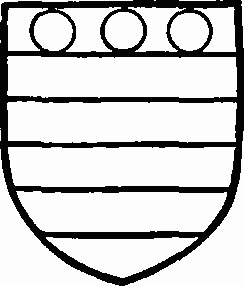
De Grey. Barry argent and azure with three roundels gules in the chief.
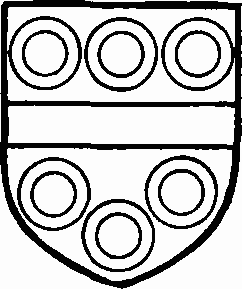
Lucas. Argent a fesse between six rings gules.
The manor of FLITTON, held in the reign of King Edward by Alwin Horim, was granted by William the Conqueror to Robert Fafiton, and was the only manor which the latter owned in Bedfordshire; it was then assessed at 5 hides. (fn. 37) Nothing further is heard of Robert Fafiton, and the overlordship passed in some way, of which no record has been found, to the Mortimers, earls of March, of whom the manor was held as of their honour of Wigmore, from 1284 until 1424, when the last male representative of the Mortimers, Edmund earl of March, died without issue. (fn. 38) There is no further record of the overlordship until 1615, when the manor was held of Richard Chetwode as of his barony of Wahull, (fn. 39) and after 1623 it is not mentioned. (fn. 40) Holding directly under the Mortimers was the family of Zouche of Ashby (co. Leic.); Roger, who was holding as early as 1232, (fn. 41) died in 1285, and was succeeded by his son Alan; (fn. 42) on the latter's death, 1314, without a male heir, (fn. 43) an arrangement was arrived at between the two daughters, Ellen, wife of Nicholas de St. Maur, and Maud, wife of Robert de Holand, by which the latter retained her father's estate in Flitton, (fn. 44) and the heirs of Alan la Zouche continued to hold under the Mortimers until 1424. (fn. 45)
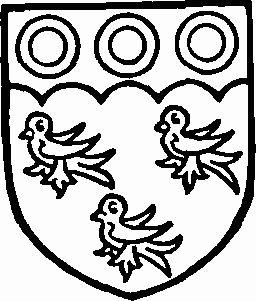
Cowper. Argent three martlets gules and a chief engrailed gules with three rings or thereon.
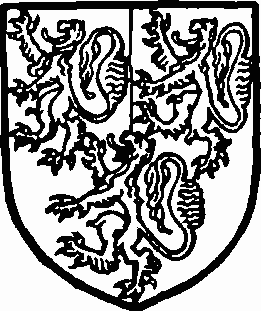
Herbert. Party azure and gules three lions argent.
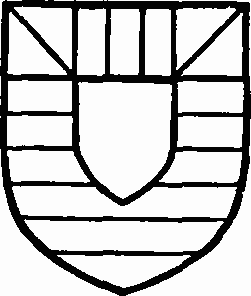
Mortimer. Barry or and azure a chief or with two pales azure between two gyrons azure and a scutcheon argent over all.
The first tenant of Flitton under the Zouches was Philip de Flitton, who in 1232 disputed with the prior of Dunstable about services from a tenement which the former held. (fn. 46) In 1284–1302 Peter de Flitton's holding amounted to one fee, (fn. 47) but between the latter year and 1314 it passed to Robert de Kendale, and had been reduced to the third of a fee. (fn. 48) It again rapidly changed hands, for by 1316 John Grey, Lord Grey de Wilton, was lord of Flitton and Silsoe, (fn. 49) and on his death in 1323 an inventory of the manor was taken. (fn. 50)
The manor has continued in the possession of the de Grey family and their descendants from the early part of the fourteenth century until the present day, following the same descent as that of the manor of Wrest, in Silsoe, in this parish (q.v.), the present lord of the manor being Lord Lucas and Dingwall.
In 1388 the manor was worth £10, (fn. 51) and by 1445 its value had decreased to £7 13s. 4d.; (fn. 52) in 1615 it included three messuages, 144 acres of land, 6 acres of meadow and 16 acres of pasture, as part of the demesne lands. (fn. 53)
There was another estate in Silsoe which became known in the fourteenth century as the manor of NORWOOD, and in the reign of Henry VIII as Norwood alias Silsoe, at first held of John peyvre; (fn. 54) the overlordship passed before 1388 to the barony of Wahull, (fn. 55) and remained vested in the barony until towards the end of the reign of Henry VII it was transferred to the crown. (fn. 56) After 1524 there is no further mention of it. (fn. 57)
This manor probably originated in the land held by Henry de Northwood, who in 1203 acquired 4 acres of land, 27 roods of meadow in Silsoe from Robert de Bray, (fn. 58) and in 1206 he leased half a virgate to William, son of Henry de Ryde, at an annual rent of 2d. (fn. 59) In 1315 Thomas de Northwood, evidently a member of the same family, held half a fee in Flitton and Silsoe of John Peyvre, (fn. 60) and in 1360 Richard, probably his son, and his wife Alice, alienated the manor of Norwood to Reginald de Grey of Ruthyn, and Eleanor his wife. (fn. 61) The de Greys, earls of Kent, and their descendants have continued to hold the manor, which has followed the same descent as the manor of Wrest until the present day, Lord Lucas and Dingwall now being the lord of the manor. There appears to have been a division of the manor between 1445 and 1456, when one third was in the possession of Thomas Boughton. Thomas was succeeded by his son Richard, who died seised of this manor in 1485, (fn. 62) leaving as his heir his son William; the third was then worth 100s. (fn. 63) William probably alienated the property to Richard Decon's father, for in 1521 Richard Decon died seised of it, the manor having descended to him as son and heir. (fn. 64) It again rapidly changed hands, for Thomas Warren, who died in 1544, (fn. 65) and Elizabeth his wife were seised of it before their death. (fn. 66) Their son Humphrey in 1539 mortgaged his reversion of the property to Edmund Conquest for £73 6s. 8d., (fn. 67) and again in 1544, after the death of his father, further mortgaged the estate, and the reversion of the property which his mother held as her dower, to Thomas Palmer for £120. (fn. 68) Humphrey was evidently unable to redeem the mortgage for Edmund Conquest at his death left his wife Joan as his executrix, and she sold the estate to Sir Henry Grey, de jure fourth earl of Kent, for £200. (fn. 69) In this way, the third part of the manor returned to the de Greys, and was absorbed in the manor proper of Norwood.
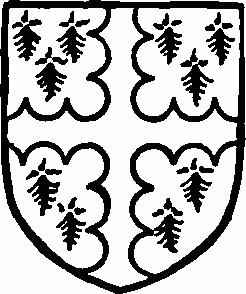
Northwood. Ermine a cross engrailed gules.
At the time of the Great Survey there was a manor in Silsoe which afterwards became known as the manor of NEWBURY (Newberry). It was then held by a concubine of Nigel de Albini, and had been held formerly by Alvric the Little, a thegn of King Edward. (fn. 70) The overlordship continued vested in the Albinis and their descendants, and the manor was held of them as of their barony of Cainhoe, the descent of which is traced under the parish of Clophill (q.v.).
By 1284 the manor had passed into the possession of the family of Fitz Richard, (fn. 71) who owned land in Silsoe before that date, for in 1201 Ralph Fitz Richard leased 1 perch of land and 1½ acres of meadow to William Wiscard for 6d. yearly. (fn. 72) The manor remained in the possession of this family, passing to Ralph's son, who was holding it in 1318, (fn. 73) and in 1396, when a settlement of the manor was made; (fn. 74) but the Fitz Richards alienated part of their estate in Silsoe amounting to one-quarter of a fee, which was held in 1302 by Ralph de Limbury and by the tenants of the lands which had belonged to Henry son of William and to William Wiscard. (fn. 75) By 1346 it was in the possession of John Morice and Margaret his wife, in right of the latter, (fn. 76) and had passed by 1428 to John Wayte. (fn. 77) The manor of Newbury and this quarter of a fee then became merged, for in 1525, at the expiration of the term of a lease of the manors of Newbury and Silsoe granted to Henry Wayte, probably a relation of John Wayte, and to Joan his wife, by Edward Daniell and others, (fn. 78) the manor of Newbury passed into the possession of the Daniell family, who held it from 1525 until 1667; (fn. 79) Edward Daniell, who was holding in 1551, was apparently succeeded by his grandson Stephen, who was lord of the manor in 1573 and in 1603. (fn. 80) Stephen died in 1631, aged eighty-four, and the manor went to his son Richard, who died shortly afterwards, apparently without male issue, (fn. 81) as the lordship was inherited by his brother Thomas, (fn. 82) according to the terms of his great-grandfather Edward's will. (fn. 83) Thomas, who owned the manorial rights in 1658, (fn. 84) died in 1664, and there was a disturbance on the occasion of his burial, William Wheeler and John Webb of Silsoe and others refusing to allow the parson to bury him, and casting him out of the church by force. (fn. 85) As Thomas died without male issue the manor was inherited by his brother William, who, with Elizabeth his wife, was in possession in 1666. (fn. 86) The history of the manor during the eighteenth century is obscure, but at some time during this period it must have been sold to the de Greys, earls of Kent, who already owned so much land in Silsoe and Flitton, as in 1833 it was in the possession of Thomas Philip, Lord Grantham, (fn. 87) whose descendant, Lord Lucas and Dingwall, owns the estate at the present day. At the beginning of the nineteenth century, Newbury Manor House was surrounded by a moat, but since then two sides have been filled in.
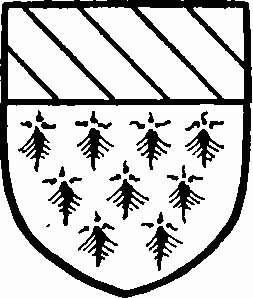
Fitz Richard. Ermine a chief bendy azure and or.
There was another estate in Silsoe, which, in the sixteenth century, acquired the name of the manor of BLUNDELLS. It was held of the de Greys as of their manor of Wrest by knight service. (fn. 88)
In 1302 Reginald de Grey and his tenants held one-twelfth of a knight's fee in Silsoe, (fn. 89) and this was held in 1346 by Roger de Grey: (fn. 90) the family of Blundell evidently held under the de Greys, for Roger Blundell in 1310 acquired 4 messuages, 80 acres of land, 10 acres of meadow, and 5 acres of wood in Silsoe and Flitton from John Blundell. (fn. 91) There is no further record of the holding until the middle of the sixteenth century, but there is little doubt that this estate afterwards became known as the manor of Blundells, which was acquired by Richard Fermour early in the sixteenth century, and held for life by Hugh Swynerton. Simon Fitz of Aspley Guise purchased the reversion from Richard Fermour, and by his will, made March, 1543, he left it to his younger son Simon. (fn. 92) Simon the father died shortly afterwards leaving a widow Alice and two sons, William his heir, and Simon, who soon became possessed of the manor of Blundells, for in 1545 he alienated it to his brother-in-law William Richardson, husband of his sister Alice, and to Thomas Fitz Hugh of Wavendon (Buckinghamshire). (fn. 93) In the course of the next year Simon died unmarried, leaving his four sisters: Susan, wife of Thomas Sterne; Elizabeth, wife of Richard Rokes; Joan, wife of William Baker; and Alice, wife of William Richardson, as his co-heirs. The three former and their husbands immediately brought an action in Chancery against Alice and William Richardson and Thomas Fitz Hugh, alleging that the alienation of the manor was illegal. In May, 1547, an arrangement was arrived at by which the plaintiffs each secured one-sixth of the manor, one-third being assigned to William and Alice Richardson and the remaining sixth allotted to Thomas Fitz Hugh. (fn. 94)
During the next few years the greater part of the manor came into the possession of Francis Morgan; in 1550 Richard and Elizabeth Rokes combined with William and Joan Baker to sell their part, or one-third, to Thomas Forster and Elizabeth his wife, (fn. 95) and the latter in 1554 sold it to Francis Morgan. (fn. 96)
The half of the manor which had been divided between William and Alice Richardson and Thomas Fitz Hugh, in the proportions of one-third and onesixth, was alienated by them to Francis Morgan in 1552; (fn. 97) the latter, who thus acquired five-sixths of the manor, died seised of them in 1558, leaving them to his wife Anne for life, and after her death to his second son Anthony, his son and heir Thomas inheriting other property. (fn. 98) Anthony evidently died shortly afterwards without issue, and this part of the manor passed to his brother Thomas. In the early years of the reign of Elizabeth, Thomas Sterne and Susan his wife, who owned the remaining sixth, brought an action against Thomas Morgan for the rent of their sixth part which they had leased to Thomas Forster, who had conveyed the remainder of his term to Francis Morgan, from whom it had descended to Thomas, the defendant. (fn. 99) Thomas Morgan had sold his interest to several persons, and it was decided that these should pay the rent; they, however, failed to do so, and three years later Thomas Sterne brought another action against the tenants of the manor of Blundells, Richard Grey, Peter Richardson, Elizabeth Hill, Thomas Swayne, Roger Hill, and John Weston, who held the manor at a rent of £10, the sixth part of which and four years' arrears amounted to £6 18s. 4d. (fn. 100) A settlement was evidently arrived at, for no further proceedings were instituted, and nothing further is heard of the tenants. The last mention of the manor occurs in 1623, when Charles, earl of Kent, died seised of it; (fn. 101) after this date it probably became absorbed into the manor of Wrest.
Another estate in this parish was owned by the prior of the Hospital of St. John of Jerusalem, who obtained a charter in 1280, granting him view of frankpledge in Flitton and Silsoe, and on this ground he claimed the view from four tenants in Flitton and eight in Silsoe in 1285. (fn. 102) In 1330, it was stated that the view was held twice a year in the priory's manor of Silsoe. (fn. 103) The priory continued to hold this estate until the Dissolution, when all its possessions were taken into the king's hand, and the greater part granted to Sir Richard Long in 1540 under the title of the Preceptory of Shyngay, in which was included lands in Flitton and Silsoe. (fn. 104) The property under the name of the manor passed to Elizabeth, the daughter and heir of Henry, son of Sir Richard Long, (fn. 105) who brought it by marriage to the Russells, earls of Bedford, (fn. 106) who were holding it as late as 1689. (fn. 107) By them it was apparently alienated to the Sandys, barons of Ombersley, who were in possession in 1768. (fn. 108) Lysons in 1805 mentions that the marchioness of Downshire, a descendant of the Barons Sandys, owned a manor in Silsoe at that date; (fn. 109) there is no further trace of the manor, but it may probably have been sold by the marchioness to the Drapers' Company, as the latter is one of the principal landowners in Flitton at the present day.
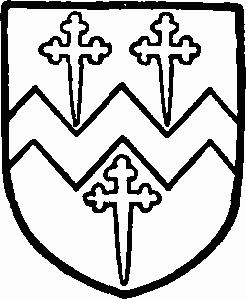
Sandys. Or a fesse dancetty between three crosslers fitchy gules.
The Butler family, who owned Higham Gobion manor, also held land in Silsoe, which they acquired in 1311 from Thomas Paynel, and 5 acres of meadow in Wrestmead, which were held of the de Greys for the service of 2s. a year. (fn. 110) This estate was in their possession from 1311 to 1413, but after the latter date there is no further trace of it. (fn. 111)
Another family who held land in Silsoe in the thirteenth and fourteenth centuries was that of Bray; in 1199 Roger de Bray held of Hugh de Bray 3 acres of land in Silsoe, (fn. 112) and in 1253 Thomas de Bray added 7 acres to his holding, which he held from Robert de Parys and Amicia his wife, for an annual rent of one root of ginger; (fn. 113) in 1259 Thomas brought an action against John de Grey, for having unjustly disseised him of his common pasture, which belonged to his free tenement in Silsoe; (fn. 114) the next year Thomas acquired more land from Anselm de Bray, (fn. 115) and in 1275 he founded a chantry in the chapel of Silsoe, (fn. 116) increasing the endowment in 1290. (fn. 117) The de Brays held land in Silsoe as late as 1361, (fn. 118) but there is no later trace of their estate.
Silsoe, which has now become a village of small importance, used formerly to possess a market; the first market, held weekly on Tuesday, was granted to Ralph Fitz Richard in 1318, in his manor of Newbury, and at the same time he was granted an annual fair on 30 April and 1 May, together with free warren; (fn. 119) in 1330 he successfully defended these rights by producing the charter. (fn. 120) These privileges apparently lapsed, for in 1715 Henry, duke of Kent, was granted an annual fair on 10 September, and a weekly market on Wednesday. (fn. 121) The market has since been disused, but the fair is still held on 13 May.
When the Great Survey was taken the manor of Wrest in Silsoe comprised a mill which was worth 2s. 2d., (fn. 122) but it apparently soon fell into decay, as in all surveys of the manor taken in the fourteenth century no mention of a mill occurs. In 1344 Roger de Grey claimed free warren in the demesne lands of his manor of Wrest, and also made good his claim to have a park there. (fn. 123) This is the first mention of the park which surrounds the manor at the present day.
Church
The church of ST. JOHN THE BAPTIST has a chancel 27 ft. by 17 ft., nave 39 ft. by 16 ft. with aisles 8 ft. 6 in. wide and south porch, and west tower 12 ft. by 12 ft. 10 in., all measurements being internal. In spite of the slight excess in width of the chancel over the nave, the whole appears to be of one build, dating from the fifteenth century. If, as it seems, the south porch is contemporary with the rest of the church, the date of completion, as given by the heraldry on the porch, will fall between 1440 and 1489. The only later addition to the plan is a large cruciform mortuary chapel of the de Greys, the nave of which is set against the north side of the chancel of the church, its south transept overlapping the east end. It is an extremely unattractive building, coated with Roman cement, and quite out of scale with the rest of the structure. The east window of the chancel has modern tracery, and bieng overlapped by the transept of the chapel, is filled with plain glass, through which one of the modern de Grey monuments can be seen. In the north wall is the entrance to the chapel, a round-headed opening with moulded jambs of late Gothic section, filled with a good wrought-iron grate of eighteenth-century date. West of it is a modern recess for the organ. The chancel is lighted on the south by two windows of fifteenth-century style, with three cinquefoiled lights. The nave has arcades of three bays and a clearstory over with three two-light windows on each side, the rood stair being at the south-east angle, carried up to form an embattled turret above the nave roof. The north aisle has two three-light windows on the north and a two-light west window, all of the fifteenth century, and there is a blocked north doorway near the west end. The south aisle has a three-light east window with tracery in the head, and two windows of three cinquefoiled lights with straight-sided heads in the south wall, which appear to be later insertions, probably c. 1500. The south doorway has a two-centred arch with continuous mouldings, and retains a panelled oak door with moulded styles which may be contemporary with it. The embattled south porch has an outer archway with a two-centred arch under a square label, the spandrels being traceried and containing shields, the one barry, which is the whole coat of Grey, the other barry with three roundels in the chief quartered with a sleeve quartering barry with an orle of martlets. These are the arms borne by Edmund Grey, grandson of Reginald, third Lord Grey de Ruthyn, who succeeded as fourth Lord Grey de Ruthyn in 1440, and was created earl of Kent 30 May, 1465. To the west of the archway a shield is inserted in the masonry, bearing ermine a chief bendy for Fitz Richard. In Fisher's Collections for Bedfordshire (1817) is an engraving of this archway showing a shield above the arch bearing a ragged bend.
The west tower is of three stages, with an embattled parapet and two-light belfry windows, and a projecting stair turret at the south-east angle. Externally all parts of the church are embattled, with flat roofs, the walling being of the dark brown local stone. The roofs of the nave and aisles are plain and a good deal of the old open seating remains. The church is rich in monuments of various kinds. In the chancel is the brass of Thomas Hill, 'receiver-general to three worthy earls of Kent,' who died in 1628, aged 101, and in the nave are indents of two brasses, one showing a man and his wife with six sons and three daughters, and another with a single figure of a civilian. On the walls of the north aisle are three fragmentary brasses, the oldest being that of Eleanor Conquest, 1434; the second, dated 1544, having a female figure with a mutilated inscription (it is that of Elizabeth, wife of Thomas Waren), and the third is an inscription, dated 1594, in memory of Alice, wife of Reginald Hill, and her infant son William.
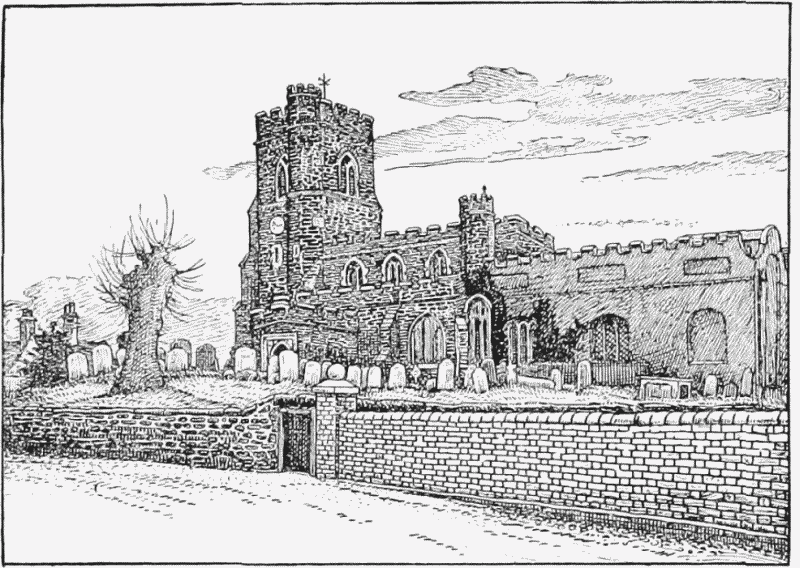
Flitton Church, from South-east
At the north-west of the nave is another slab with indents of a figure between four shields, one of which, bearing a lion, is preserved in the vestry at the west end of the north aisle. A rubbing in the collection of the Society of Antiquaries shows the lion shield apparently in position on the slab of Eleanor Conquest.
Part of the inscription of the Waren brass is a palimpsest, having part of a fifteenth-century inscription on the back.
The de Grey chapel contains a long series of monuments, the oldest being those in the western wing, which is also the oldest part of the chapel, c. 1614, the eastern parts having been added in 1705. The earliest monument is that of Henry Grey, fifth earl of Kent, 1614, and Mary (Cotton) his countess; their alabaster effigies lie on a panelled altar tomb, and above is a cornice with heraldry, and two marble panels with inscriptions. Next to their tomb on the east is that of Henry, ninth earl, 1651, and his countess Arabella, 1658, of white marble. Other monuments here are those of Lady Elizabeth Talbot, 1651; Lady Jane Hart, 1673; and slabs to Charles Grey, 1623, and his son Henry, 1639. In the north transept of the chapel are the tombs of Henrietta de Grey, 1703, and Henry de Grey, 1717, and at the crossing those of Amabel de Grey, 1727, and Anne, 1770. In the south transept lie Thomas Philip, Earl de Grey, 1859, and Henrietta de Grey, 1805. In the east wing are the monuments of Henry, duke of Kent and Marquess de Grey, 1740, Jemima de Grey, 1728; Sophia, 1748; Ann Sophia, 1780; Philip, earl of Hardwicke, 1790; and his wife Jemima, Marchioness de Grey in her own right, 1797; Amabel, their daughter, Countess de Grey, 1833, and her sister, Mary, Baroness Grantham, 1830. There is also a brass, removed from the church, to Harry Gray, son of George, earl of Kent, 1545, with a large quartered shield above an armed figure.
There are five bells, the treble by Bowell of Ipswich, 1904; the second, and third by the same founder, 1902; and the remaining three by Richard Chandler of Drayton Parslow, 1687.
The plate consists of a cup and standing paten of 1838, given by Earl de Grey in 1846, a plated flagon given in 1831, and two pewter almsdishes.
The first book of the registers begins in 1591 and goes to 1665; the second runs from 1653 to 1685, and the third begins in 1678 and contains burials to 1718, baptisms 1637 to 1719, and marriages 1689 to 1720. The fourth book has baptisms and burials 1762 to 1783, and the fifth the same to 1813. The sixth is the printed marriage register 1754–69, and the sixth its continuation to 1813. There are several fragments of churchwardens' accounts, the earliest being of 1632, and several lists of parish rates from 1598. There is also an early printed brief of 1580 for the repair of the haven of 'Colliton' in Devon.
Advowson
Until the Dissolution in 1536 the church of Flitton belonged to the abbey of Elstow, (fn. 124) but the date of the gift and the name of the benefactor are not known. In the time of Pope Alexander III, 1159-81, the right of presentation already belonged to the abbey, and the bishop of Ely, by the mandate of the pope, settled a dispute over the churches of Pulloxhill and Flitton which arose between Dunstable Priory and Elstow Abbey. (fn. 125) Flitton vicarage is said to be one of the earliest to be ordained in Bedfordshire. (fn. 126) In 1291 the church was worth £8, (fn. 127) and in 1535 the value of the church and chapel had increased to £13 6s. 8d., out of which the abbey had to pay a pension of 40s. to the vicar of Flitton. (fn. 128) The church became crown property after the Dissolution, the king presenting in 1541, but in 1546 it was bestowed upon the dean and chapter of Christ Church College, Oxford, who own the right of presentation at the present time. (fn. 129) Since the beginning of the nineteenth century, however, the advowson has been held on lease from the college by the de Greys of Wrest, Lord Lucas and Dingwall being the present lessee. (fn. 130)
The Committee for Plundered Ministers increased the value of the living in 1646 out of the rectorial tithes of Luton, sequestered from Sir Robert Napier, a delinquent; it was then ordered that £50 annually should be paid for the maintenance of the minister of Flitton and Silsoe, as his stipend was only £35 and there were two churches with 340 communicants. (fn. 131) The vicar at this time was one William Ramsey, instituted in 1628, who on 17 January, 1645, was summoned to appear the following April before the Committee of Plundered Ministers at Westminster, to answer a charge of drunkenness; he failed to appear, and, on 11 May, 1647, was proved to be a common drunkard. (fn. 132) In 1655 the vicar was ejected for refusing to conform to the standards of Presbyterianism, but nevertheless he maintained an obstinate resistance, and for a long time remained in the parsonage. (fn. 133)
There was a free chapel of St. Leonard in Silsoe appendant to the mother church at Flitton; the earliest mention of it occurs in the Liber Antiquus (1209–35) of Bishop Hugh Wells, in which it is stated that it belonged to the abbey of Elstow, but the exact date of the foundation is unknown. (fn. 134) In the thirteenth and fourteenth centuries two chantries were founded in the chapel by Thomas de Bray and Ralph Fitz Richard, who owned Newbury manor. The former of these was founded in 1275 (fn. 135) and in 1290 Thomas de Bray increased the endowment by granting one messuage of land and rent in Silsoe to the chaplain there. (fn. 136) The chantry of Ralph Fitz Richard was endowed in 1327 with one messuage and rent in Silsoe, (fn. 137) and John de Grey was also a benefactor, for in 1311 he bestowed one messuage and 5 marks rent in Flitton, Silsoe, and Wrest upon the chantry. (fn. 138) Between 1486 and 1493 the chapel was the occasion of a dispute between Richard Hyneman, priest, and Thomas Eymewe. The former had agreed to resign the chapel to John Eymewe in return for an annuity of 100s. to be paid by Thomas Eymewe. The plaintiff having fulfilled his part of the contract, the defendant refused to carry through his, and also brought an action of trespass against Richard Hyneman in the name of one Symgwyn, then master of the free chapel. (fn. 139) In 1535 Hugh Maney, the rector of Maulden, was also minister of this chapel, and stated its value to be £3 10s. (fn. 140) while Edward Philips, the vicar of Flitton, affirmed that £3 9s. 3d. was paid out of his vicarage to the chapel as the salary of the minister. (fn. 141) In 1539 Humphrey Warren, the son of Thomas and Elizabeth Warren, sold the reversion of the advowson of the chapel to Edmund Conquest, together with the chapel of Norwood manor, which at that time was held by his parents. (fn. 142) This chapel was dissolved under the Act of Edward VI. At the date of its dissolution Sir Henry Grey and Edward Daniell were the patrons, and presented the chantry priest, at that time Hugh Maney, who had not visited Silsoe for thirty years, but lived in Cheshire. The service was conducted by another priest, found by the vicar of Flitton, and paid out of the possessions of Elstow Abbey. It was stated that the chantry was of no use, although a mile distant from the church of Flitton, and that no goods or ornaments belonged to it. (fn. 143) The dissolved chantry in 1551 was bestowed upon Edward Warner and John Goswood, to be held in free socage as of the king's manor of Eye, (fn. 144) but by 1573 it was in the possession of the de Grey family, and was held by them as late as 1623. (fn. 145) The place of the chapel was taken by a chapel of ease built for the use of Wrest House and the tenants: this latter had to be pulled down in 1831 as unsafe, when an addition was being made to the steeple, and the present church of St. James was erected on the site. (fn. 146) The vicarage is in the gift of Lord Lucas and Dingwall.
There is a Wesleyan chapel at Greenfield.
Charities
The following charities are administered under an order of the Charity Commissioners of 1898, namely:—
Charity of William Daniel, £122 15s. 11d. consols, income to be laid out in bread in the proportion of 2/5ths to poor of Flitton, and 3/5ths to poor of Silsoe.
Mr. Cox's gift of £20 upon similar trusts, represented by £24 8s. 11d. consols.
Earl of Kent's gift of £170 for education of poor children of Flitton and Silsoe in the proportion of 2/5ths and 3/5ths respectively. The trust fund now consists of £208 15s. 3d. consols.
Henry Sharp's Legacy of £100 consols for repair of monument, surplus income for poor of Flitton in bread in January. A sum of 2s. 6d. is retained annually for repair of monument.
The Rev. John Robinson, vicar of Flitton, who died in 1817, by his will devised certain real estate for poor of Flitton. The demise being void in mortmain, the testator's heiress, Mrs. Godwin, set aside £100 consols in furtherance of his charitable design, for poor of Flitton and hamlet of Greenfield, the dividends to be distributed in bread in the parish church yearly on the second Sunday in January.
The several sums of stock are held by the official trustees, and the dividends are applied in accordance with the trusts of the charities respectively.
The Town Lands consist of land and two cottages and gardens allotted on the inclosure in lieu of certain pieces of open-field land, held immemorially for the repair of the church. The income amounts to about £23, which is applied in aid of the church expenses.
The Turf Lands, 13 acres, were set apart on the inclosure for digging turf for firing for the poor, and by the Inclosure Act of 49 Geo. III, it was directed that the rent or herbage thereof should be laid out in the purchase of more fuel for the poor. The land is let to labourers in shares, and produces about £10 a year, which is distributed in coal equally between Flitton and Silsoe, under the title of Moor Coal.
Silsoe Church Estate consists of cottages and 15 acres or thereabouts, awarded on the inclosure in lieu of open-field lands held immemorially for the repair of the chapel at Silsoe. The net income is about £30 a year, which is applied in defraying the expenses in connexion with the church.